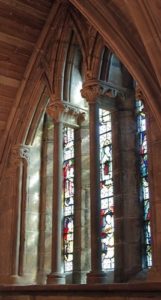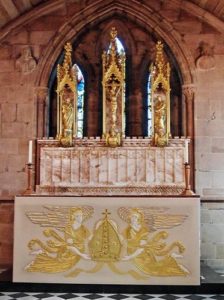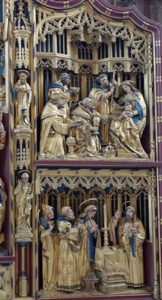With its three spires, this is affectionately called the Ladies of the Vale. We have been intending to visit for years. It is worth walking round the close, one of the best preserved in England, for views of the outside of the cathedral. The Bishop’s Palace is now the cathedral school. The Chapter’s Restaurant is busy, although we weren’t impressed by it.
There has been a holy site here since the martyrdoms of Christians during Roman Times. St Chad moved his See from Repton to Lichfield in 669 and the first cathedral was built around 700AD to house the bones of St Chad. The original wooden Saxon church was replaced by a Norman building in the 11thC and the present Gothic Cathedral was begun 1195 as the cathedral had become a major pilgrimage site. It took over a hundred years to build. The choir dates from1220 and the transepts 1220-40. The octagonal chapter house was finished in 1249 and work on the nave began in 1260. The Lady Chapel was the last to be built and eventually finished in 1330.
It was surrounded by a ditch and defensive walls. The remains of these can be seen a the junction of Dam Street and the Close. The Close was fortified during the Civil War as the cathedral authorities supported the king while the townsfolk sided with parliament. It was the scene of fierce fighting and cathedral sustained considerable damage. The central spire was demolished, roofs ruined and medieval glass smashed. Restoration began in 1660 and it took until the 19thC before the building was completely restored. The 15thC library was pulled down as it was deemed to be unsafe The books were moved to the chapter house.
In the 19thC, the Minton tiles were replaced in the choir. The west front was completely renovated by Sir George Gilbert Scott as a lot of the carvings were either damaged or badly eroded.
The central spire was rebuilt in the 1950s and the Close paved. St Michael’s Chapel was redesigned as a military chapel of the Staffordshire Regiment. Restoration work still continues. The Flemish stained glass windows in the Lady Chapel have been removed for storage as the sandstone window surrounds were suffering erosion and water was getting in.
The Cathedral is the most amazing building from the outside with its three spires rising to the sky from square towers. There is so much detail with every surface carved, it is almost impossible to describe. You really do need to see it for yourselves.
The chancel and Lady Chapel are as long, if not longer than the nave and have flying buttresses from the side aisle to the clerestory roof. On the outside of the south wall are remains of wall tombs, set under carved ogee arches with a triangular top. There is a highly carved south doorway with steps leading up to two blind arches on either side and carved figures of saints in the arches above. To the left of the doorway is a large and now quite eroded statue of Charles II which originally stood on top of an ornamental gable between the two spires.
The side aisles are buttressed with carved statues and there is a low open carved battlement round the top of the chancel with crocketed (nobbly) pinnacles. The nave has massive buttresses with more flying buttresses to the clerestory with pinnacles along the top.
The west tower is a mass of carved detail with blind arches, crocketed pinnacles and tall towers. The front is covered with carvings of bishops, kings and saints. All have their names carved beneath them, but you need binoculars to read them. There is a central doorway with smaller doorways on either side, all highly carved. The tympanum above the main door has a carved image of Christ in Majesty. Above the central window is a statue of Christ giving the blessing with a small cross above.
The north door has a double doorway with carved arches and statues of the Virgin and child and also of St Chad.
The inside is equally impressive. There is a massive nave with elaborate multi-angular pillars which have carved capitals with foliage and a series of pointed arches separating nave and side aisles. These have blind arcading along the bottom of the walls with brass and marble memorials above.
There is a passageway round the clerestory which has double pointed arches with a central pillar. There are carved faces at the base of the arches. Ribs from the pillars continue to the vaulted ceiling with carved bosses. Originally the nave ceiling had been stone, like the side aisles but so much stone had been used in the construction, the side walls were beginning to bow out under the weight. During the 18thC restoration, 200-300 tons of stone were removed and the present plaster ceiling with stone ribs was added.
At the end of the nave is a modern altar on a grey and white marble plinth. The Lichfield angel was discovered under the floor here in 2003.
There is a very delicate and beautiful open metal work screen separating the choir and nave which has painted flowers and gilded angels. These represent the angels who came to play and sing to St Chad. The pulpit is similar open metal work.
The south transept contains military memorials and books of remembrance for both world wars. The huge memorial with flags and sphinx commemorates officers, non-commissioned officers and soldiers of the 80th Regiment of Foot of the Staffordshire Volunteers who fell in the Sutley Campaign in 1845 & 1846.
The south aisle along the choir is lined with tombs of bishops. A wooden door leads to the Consistory Court which contains a small treasury with church plate from the 17thC, pastoral staffs and a bishop’s crozier set with semi-precious stones.
Next to it, steps lead up to St Chad’s Head Chapel. His skull was kept here and could be displayed to pilgrims from the stone balcony outside the chapel. (His bones were lost in 1540 during the Reformation). It is a small chapel with an altar with an embroidered front in white and gold with two angels holding a bishop’s mitre. The stone retable has gilded pinnacles and a carving of Christ crucified with the Virgin Mary and St John on either side. Below are angels holding monogrammed shields.
In the south aisle along the side of the choir is the remains of a 14thC wall painting of the Holy Trinity. In the centre is God the Father although only his head and feet are left. He is holding Christ and we could just see his legs. The dove representing the Holy Spirit has been lost. On either side are angles holding censors. Below is Bishop Langton’s tomb.
The choir has a superb wooden bishop’s chair with a high back and a canopy. Choir stalls have the names of the occupants inscribed along the top and painted shields along their backs. The floor is tiled and there are images of kings and bishops set in the tiles. To the right of the high alter are five carved stone seats with pinnacled tops.
The high altar has a gold and scarlet front piece. Behind is a beautiful marble reredos with different coloured marble pillars with pointed arches covered with crocketed pinnacles. This was made from the medieval screen which stood at the entrance to the Lady Chapel. In the centre is Christ in Majesty set in an arch of semi-precious stones, with statues on either side and winged angels below.
The rear of the reredos has a carving of the Virgin Mary praying. St Chad’s shrine once stood here.
The Lady Chapel is behind the choir and is now light and airy with plain glass in the windows. The 16thC Flemish glass from Herckenrode Abbey is currently in storage as the sandstone window frames were becoming badly eroded. These are being replaced and the Flemish glass will be set in tungsten brass surrounds and protected by clear glass on both sides.
Along the walls between the windows are blind arches with crocketed pointed arches containing statues of saints. The altar has the most amazing triptych with a carved central panel of the Virgin Mary and Christ Child in the centre. Around it are images of the nativity, including the annunciation and the adoration of the Magi.The doors have painted blue and gold panels with saints and a bishop.
The north aisle has a marble reredos on the wall with a crucifix carved on it. In front is a bank of candles.
The passageway to the chapter house leads off the north aisle and is a unique example of a medieval pedilavium where, following the example of Jesus at the Last Supper, feet are washed on Maundy Thursday. This has an open arcade of double pillars along the west wall with either heads or foliage between the arches. Along the base is a stone seat with red cushions.
The octagonal chapter house has blank arcading round the walls with heads or foliage and a bench round the base. A central pillar with a carved capital supports the stone vaulted ceiling. Above the doorway is the remains of a 14thc wall painting depicting the Assumption of the Virgin with a small figure of God the Father at the top and angels around the Virgin.
The Lichfield Gospels, also known as St Chad’s Gospels, are displayed here. They are thought to date from 689-800 and have been in Lichfield since the 11thC. Know one knows where they were written or who wrote them. We were disappointed as it was open at two pages of script with no illustrations. There is a computer screen with more pages form the gospel.
The other treasure is the Lichfield Angel. This is an 8thC carved limestone panel which was originally part of a chest thought to contain the relics of St Chad. It is thought to be Gabriel and be half of the annunciation scene.
There are two display cases with pieces from the Staffordshire Hoard, discovered in a field near Lichfield in 2009 and the largest hoard of Anglo-Saxon gold and silver metalwork found. It is thought to be 7th or 8thC. The collection displayed here is mainly gold sword hilt fittings. The beautiful cross set with red semi-precious stones is a replica.
Lichfield Cathedral is an amazing building and well worth visiting. Inside the entrance is a notice advising visitors they need to buy a photography permit from the shop at the back of the south aisle. This costs £2 and you are given a sticker to wear. However we did see several people taking photos without a sticker.










